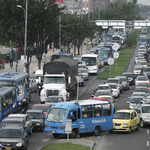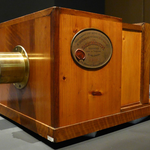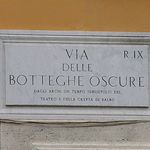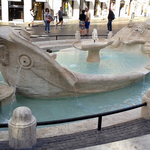Piazza del Popolo
It was the pope Sixtus V who decided to arrange here a square at the end of '500. Until then it looked like a wide street surrounded by haylofts and barns in the dusty periphery.
Besides town planning the pope was fond of constructing obelisks. So on May 25, 1589 he ordered Domenico Fountain to put up the Flaminio obelisk. The project like this was some sort of a show in those times. If an architect was not able
to raise up the obelisk within maximum 12 hours his head should be cut off. If he succeeded however, there would be 10 years of indulgence for the spectators who confessed themselves and did not disturb the works. Naturally as it is possible to see also today the project succeeded. Domenico Fontana for not to lose the head increased all the things : he used 140 horses, 14 buffalos, 40 gigantic capstans,a thousand of workers and spent lots of money, 40 thousand shields exactly.
Since that day the square had become a stage.
The obelisk of 24 meters high, sized in 36,50 meters together with the basement is the most ancient after the Lateran one. It was raised up in Eliopolis in front of the Temple of the Sun at the time of the Pharaonhs Ramses II and his son Mineptah (1232-1200 A.C). The hieroglyphic inscriptions referred to this fact. It was taken out to Rome by August as the spoils and was placed into the Circus Maximum.
In 1811 Giuseppe Valadier invited by Napoleon gave the neoclassical appearance to it making an accent on the open theatre features and making it really scenographic. The area is encircled by two side hemicycles. On the lean of the PINCIO a series of scales and terraces adorned by statues can be seen. It constitutes an ideal dress-circle for to see what happens in the square.
The romantic travellers of the XIXth century call it the show of the life.
In 1823 Lion XII constructed a base of the obelisk adorned with four basins and the marble lions.
In 1825 the carbonario Montanari and Targhini who contested the government of the Pope was beheaded here by the most famous executioner of Rome Mastro Titta.
At the beginning of XXth century two famous caffes were open at the corners of the square: Canova and Rosati, one in front of the other.
By one of those little ironies of the history the square becomes the favourite place of those who makes a show instead of watching it. On the tables of Rosati about tens of films were created and there is no italian or foreign actor or actress
who wouldn't stop once at least in the square "to feel the wind".
At the beginnings of '500 from the left of the stairs the Tridente was open. It consists of Via di Ripetta which reaches the Lungotevere in Augusta, the Via dell'Ara Pacis with the Mausoleum of August, the Via del Babuino that leads to
Piazza di Spagna, and the Via del Corso in the center with its thin line until Piazza Venezia, The street is framed by two XVIIth century twin churches. Santa Maria dei Miracoli was built in 1675-81 by Carlo Rainaldi and Carlo Fontana and the Santa Maria di Montesanto which was designed in 1662-79 by Gian Lorenzo Bernini.
On the right side one can see the Porta del Popolo. It is an heir of Porta Flaminia belonging to the Aurelian circuit, being the main entrance gate to Rome during more than one thousand years for those who came from the north. The extraordinary façade was built in 1561-62 by Nanni di Baccio Bigio. The interior side was added by Gian Lorenzo Bernini in 1655 for the occasion of the arrival of the Swedish queen Cristina.

 The records of Rome. Big numbers, not always enviable, for a big city.
The records of Rome. Big numbers, not always enviable, for a big city. New Phot-O-Matic section. To spend some time looking at photos (also) of Rome.
New Phot-O-Matic section. To spend some time looking at photos (also) of Rome. The administrative, urban, toponymic and imaginative subdivisions of Rome.
The administrative, urban, toponymic and imaginative subdivisions of Rome. Notice for tourists: in Rome you drink for free. Historical fountains and 'big noses'.
Notice for tourists: in Rome you drink for free. Historical fountains and 'big noses'. Free museums return on the first Sunday of the month.
Free museums return on the first Sunday of the month.